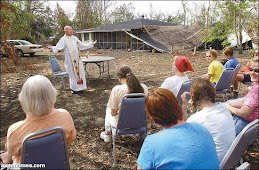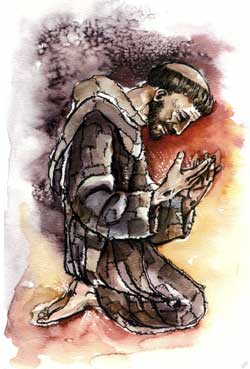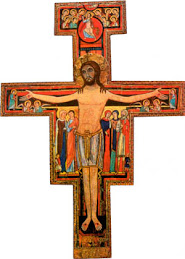by Ouida L. Tomlinson, SFO
We are all called to holiness (Lumen Gentium) and are called to make this journey into God.
The Journey consists of three steps. Bonaventure uses symbols of the temple in Jerusalem for the three steps: (1) temple court; (2) temple sanctuary; and (3) into the holy of holies where Christ is symbolized by the Mercy Seat. He also describes the three steps as evening/dusk, morning/dawn and noon. He further divides the three steps into six steps or levels of ascent, written in six chapters, with the seventh chapter being union with God. The six wings of the Seraph symbolize the six levels over which the soul passes, the six steps of illumination which lead to God.
On days 1 and 2, we begin by looking without ourselves to creation. The world outside us comes to us through our senses, and our journey begins with the world through our senses of sight, touch, smell, taste and hearing. In creation we see the vestiges or footsteps of God. We “behold God in vestiges, like the two wings covering the Seraph’s feet . . . .”
"Whoever, therefore, is not enlightened
by such splendor of created things is blind;
whoever is not awakened by such outcries is deaf;
whoever does not praise God because of all these effects is dumb;
whoever does not discover the First Principle from such clear signs is a fool.
Therefore, open your eyes alert the ears of your spirit open your lips
and apply your heart so that in all creatures you may
see, hear, praise, love and worship, glorify and honor your God . . . . "
by such splendor of created things is blind;
whoever is not awakened by such outcries is deaf;
whoever does not praise God because of all these effects is dumb;
whoever does not discover the First Principle from such clear signs is a fool.
Therefore, open your eyes alert the ears of your spirit open your lips
and apply your heart so that in all creatures you may
see, hear, praise, love and worship, glorify and honor your God . . . . "
On days 3 and 4 we go within to consider the image of God through the three-fold powers of our memory, intellect and will. “These two middle stages . . . are like the middle wings of the Seraph spread out for flight.” We enter into ourselves, into our mind, where the divine image shines forth. On day 4 our inner world is expanded to include our willingness to be enlightened by grace. Sin blunts our ability to choose well, and grace helps us to make better choices.
"Therefore, no matter how enlightened one may be
by the light of natural and acquired knowledge,
he cannot enter into himself to delight within himself in the Lord
unless Christ be his mediator, who says:
I am the door. If anyone enters through me,
he will be saved; and he will go in and out and will find pastures.
But we do not draw near to this door
unless we believe in him, hope in him and love him."
On days 5 and 6 we look above ourselves, trying to see God as God is and gazing into more light (darkness). Day 5 sees God as one and day 6 see God as Trinity.
"We can contemplate God not only outside us and within us but above us;
outside through his vestiges, within through his image
and above through the light of Eternal Truth . . . . "
On day 7 we die to self, we surrender our will to enter into the dance of the Trinity, and we pass over to the Father. The intellect yields to feeling – to the heart. The soul rests from intellectual activity.
"In this passing over, if it is to be perfect,
all intellectual activities must be left behind
and the height of our affection
must be totally transferred and transformed into God."
Bonaventure says that no one enters except through the burning love of the Crucified. One enters the heavenly Jerusalem through the blood of the lamb, and one is not disposed to make this journey unless they are a person of desires, burning with spiritual passion. Desire is the heart of prayer, and prayer transports us on this journey.
“Blessed is the man whose help is from you;
in his heart he has prepared to ascend by steps
in the valley of tears,
in the place where he has set.” Psalm 83:6-7.
Bonaventure says that no person can be happy unless they arise above themselves and that this is possible only with the help of Divine aid which is available to those who seek it from their hearts in fervent prayer. “Prayer, then, is the mother and source of the ascent.”
 Francis’ vision of the Six-Winged Seraph
Francis’ vision of the Six-Winged Seraph------------------------------
Source for quotations are from The Soul's Journey Into God by St. Bonaventure.
I'm only an ordinary Secular Franciscan, without any courses in theology or Bonaventure so do not accept anything I have said here as coming from one who speaks with authority. Comments, suggestions, and sources to further my understanding of this marvelous work will be appreciated. Thank you.


















No comments:
Post a Comment